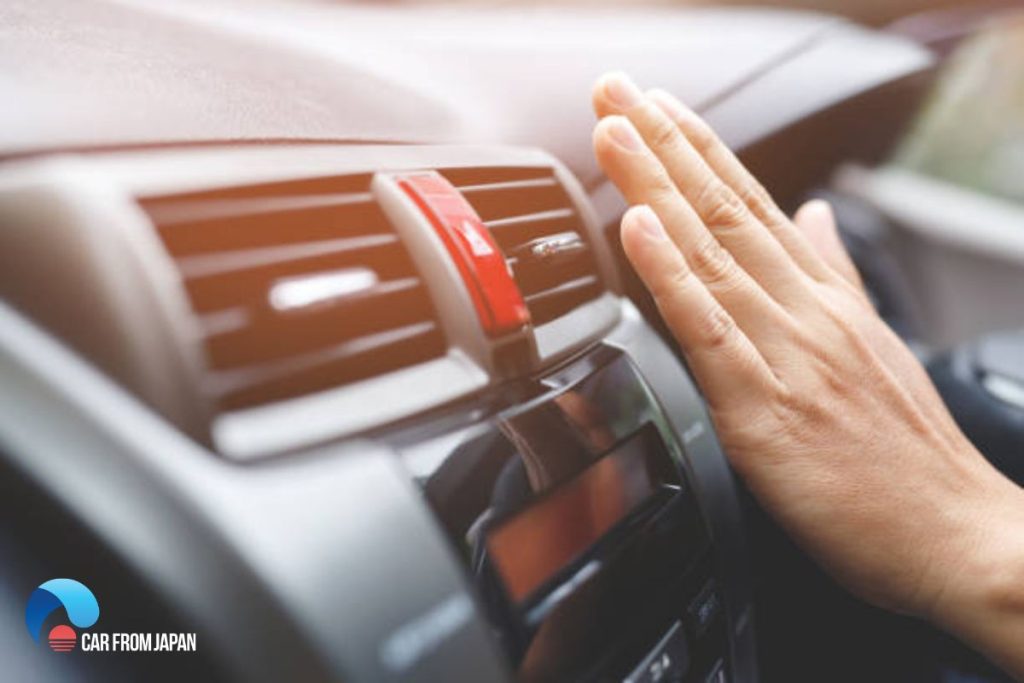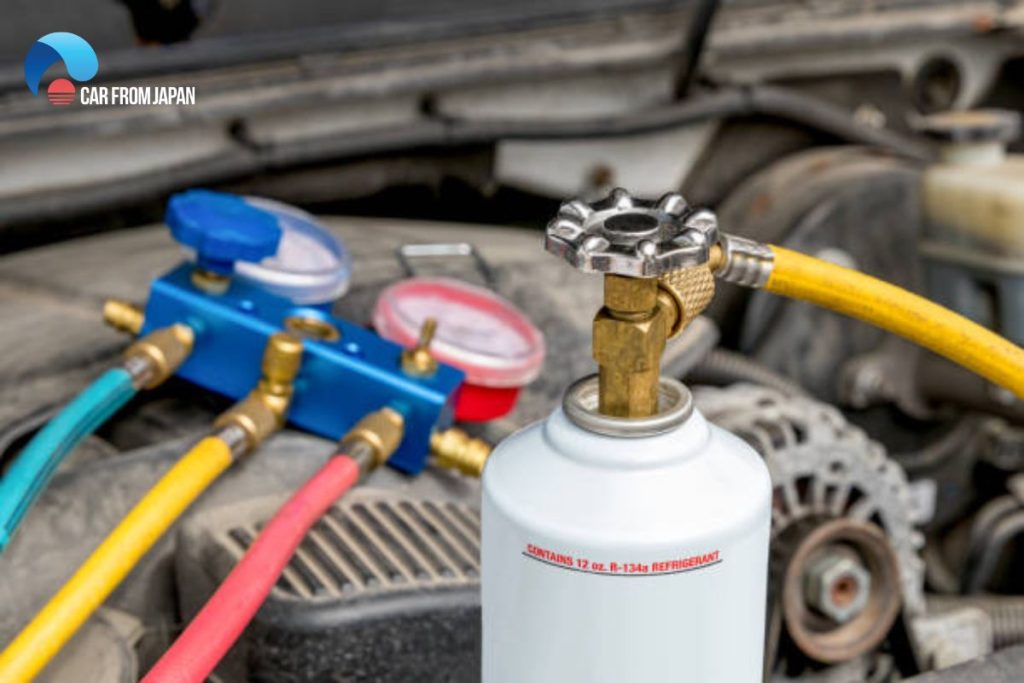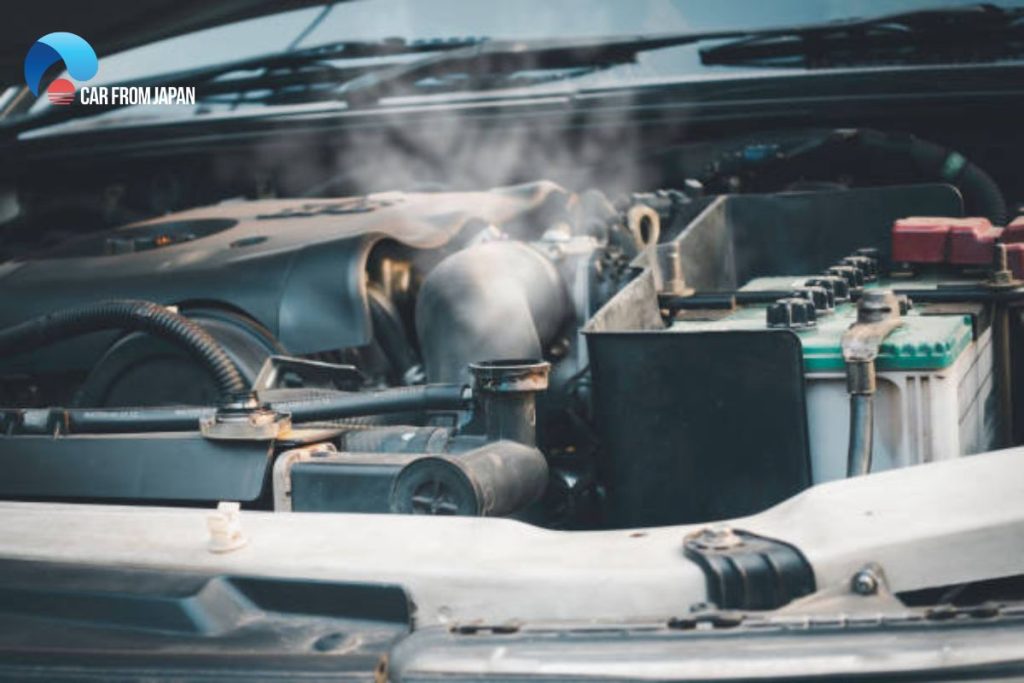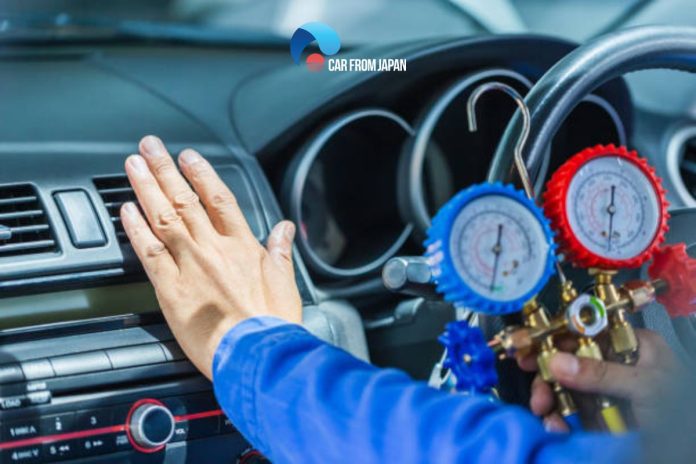It’s bloody hot in the summer, and it’s bloody frustrating when you turn on the AC to get a draft of cool air but instead, get nothing. Car air conditioner not blowing cold air when idling is a pretty common issue related to your vehicle’s AC unit.
There are many reasons why you might find the AC cold when driving but not at idle. Read on to learn the most common reasons as well as how to fix the problem in each case.
Contents
The Basis of Car Air Conditioner
Before diving into the possible culprit that can cause a car air conditioner not to blow cold air when idling, you should grasp the basics of how your car’s air conditioning unit works. This will make troubleshooting and fixing the problem more self-explanatory.
The air conditioning system in your car requires a refrigerant for operation and consists of a compressor, condenser, evaporator, orifice tube, and accumulator. The compressor compresses the refrigerant into a liquid.
As the gas gets compressed, it heats up, and the high pressure forces the refrigerant to travel through the system to the condenser. The condenser features a section of coils that the cool air from outside passes over, thus transferring the heat from the compressed gas to the air.
The refrigerant then goes through the dryer to get rid of contaminants. Once purified, the compressed refrigerant passes through the expansion valve, where it is stripped of its pressure. After traveling through the evaporator, the refrigerant is now super clean, dry, and cold.
To create the gusts of cold air blowing out of your car’s AC, the air is sent through this newly cold refrigerant in the compressor tank to cool down and then blown out through the blowers.

Car Air Conditioner Not Blowing Cold Air When Idling: Common Reasons
The problem occurs in most cars at some point in their lifetime. Poor maintenance of the air conditioning unit is the main cause for the AC not blowing cold in car. Checking the system from time to time is crucial to keeping it in good condition. Let’s see what could be the probable reasons for the car AC not blowing cold air when idle.
Faulty condenser fan
The cooling fan in the condenser is the first thing that you should look into when finding out the reasons for a car air conditioner not blowing cold air when idling. If the fan is damaged or cannot run with its full force, it cannot cool down the heat coming from the Freon (refrigerant) through the condenser.
When the car runs at a high speed, the condenser does not require the fan for cooling the Freon because of sufficient air passing through it. But when the car is not moving, the fan is the only tool for making the Freon cold.
You should check if the fan’s connections are loose if it does not properly sit in its slot or if there’s any damage that would impede its operation.
Low freon level
The Freon gets used up with the running of the air conditioning. When its level goes lower than the acceptable level, you will face the issue of the car air conditioner not blowing cold air when idling.
The compressor can pump the Freon more easily when the car is running at a high speed on the highway but it struggles when the car sits idle. You can do the refill yourself if you know the procedure.
Another sign of a low Freon level is if you don’t hear the clutch engaging the moment you turn your vehicle’s AC on. The clutch allows the compressor to pressurize the freon and works by reading freon levels. If it doesn’t activate, the reason would be that there’s not enough freon.
Leakages
One possible reason for the low Freon level is a leak in the AC condenser. The condenser seals and tubes are prone to normal wear and tear; they can crack or break.
Another possibility is damage from physical impact by road debris or rocks, as the condenser is located near the front of a car. A leak in the condenser can lead to a low refrigerant charge and thus poor AC performance since the system relies on the refrigerant for operations.
You normally won’t be able to notice condenser leaks by eyes. If you look closely, all you’re likely to see is a faint outline of refrigerant oil.
Sometimes, for older cars, a trace dye that is bright green is added to the A/C system for easily detecting condenser leaks (your vehicle operates on many fluids, and each has a distinct color, so don’t mistake them).
If the condenser is leaking excessively, you’ll need to replace the entire condenser as it’s not possible to replace cracked or broken seals or tubes. In this case, you’ll likely need a professional to find and repair the leak and restore the refrigerant to the correct level.

Detecting leaks
Leaks most commonly occur in worn O-rings, seals, and hoses of the air conditioning system, followed by leaks in a pinhole of the condenser and evaporator, and leaks in the compressor shaft seal.
To detect leaks, add refrigerant to restore it to the correct level, then turn the AC on. The simplest but effective method is to spray soapy water on suspected areas and watch for bubbles.
If a leak occurs in the O-rings, seals, or hoses, simply having them replaced will solve the problem. However, if the issue lies with a leaking condenser, evaporator, or compressor shaft seal, the repair is expensive and more troublesome, which should be performed by a professional.
Clogged condenser
If any foreign object or debris gets into the condenser and obstructs the fins, the cooling process won’t work properly, especially when the car is idle.
Condensers are subject to clogs over time due to the buildup of residue in the refrigerant, which eventually turns into a sticky paste that hinders the heat transfer that can take place from the hot refrigerant to the cool ambient air that gets blown over the condenser coil.
The second cause for a condenser malfunctioning is a blockage caused by debris. This is typically due to a worn compressor that is breaking apart and dispersing metallic internal parts throughout the entire system.
This means that if you’re dealing with a blockage, you might need to replace not just the condenser but also the failing AC compressor, the tubes, and the receiver/drier or accumulator since metallic debris has contaminated the whole system.
A blocked condenser might also cause a problem called short cycling, which makes the A/C unit cycle on and off rapidly and ineffectively instead of optimally.
This abnormal cycling will cause more wear and tear on all components, thus, you might have to replace many parts at the same time or replace the whole A/C unit prematurely.
In this case, you just need to clean the dirty parts to resolve the problem of the AC not blowing cold air:
- A dirty or clogged condenser: If your condenser is clogged with dirt or anything that’s interfering with the unit, simply give it a thorough cleaning to restore the unit’s optimal performance.
- Dirty coil: The coil is the part that the cool ambient air gets blown over, so over time, it is also prone to collecting dust and other contaminants in the air. You just have to clean off debris from the coil to restore the condenser’s capability.
Broken or Worn condenser parts
The condenser itself consists of multiple parts: the coil, the motor, the fins, the condenser relay switch, the run capacitor, plus tubes and seals. If these parts become dirty or become worn with old age, your condenser might lose its function.
Sometimes, you can clean or replace the faulty part itself, and you’ll need to replace the whole condenser or the entire A/C unit.
If you’re lucky, you can just replace certain faulty components as follows:
- Faulty motor: A faulty motor needs to be replaced. But note that you must check your owner’s manual for the correct replacement motor to avoid causing even more damage to your air conditioning unit.
- Bad condenser relay switch: easy replacement
- Bad run capacitor: easy replacement
But sometimes, you’re less lucky. If you’re dealing with the problems, you’ll need to replace the entire condenser itself, or worse, the entire air conditioning unit:
- Condenser blockages: A blockage caused by metallic debris from a failing compressor is a major issue. Most of the time, you may have to replace more than the condenser itself or, worse, replace the whole air conditioning unit.
- Damaged coil: A damaged coil is very hard, expensive, and time-consuming to repair unless your coil is still under warranty. Otherwise, people usually replace the entire air conditioning unit, which is quicker and cheaper.
The average cost for an AC compressor replacement is between $400 and $900, depending on the particular car. About half of this would be labor costs, and the remaining is the price of the parts.
Overheated engine

Another common reason for a car air conditioner not blowing cold air when idling is an overheated engine. Most cars have two cooling fans, one for the condenser and the other for the radiator.
The compressor of the AC system moves heat from the radiator to the condenser. When the car is already overheated and the fans in the radiator and condenser are not working properly for some reason, the system can’t cool down the heat with maximum efficiency.
Restricted system
Restrictions within the A/C system can also serve as the root cause behind poor cooling. A restriction stifles refrigerant flow, often leading to inadvertent variances in system pressures. As a result, cooling often suffers quite dramatically.
To diagnose and fix the restricted system issues causing the car AC not blowing cold air when idle, it’s best to take your car to a professional mechanic.
Faulty sensors
A full A/C system always includes a few sensors, all of which give important input for the car’s air conditioning system to perform effectively. The following sensors, as well as their general purpose, are:
- Low pressure switch: The low pressure switch is designed to detect the relative loss of refrigerant, as well as lubricating oil. The sensor will be deactivated to disable the system’s compressor, minimizing the risk of damage.
- High pressure switch: The High pressure switch detects refrigerant overpressure.
- Ambient temperature sensor: This sensor is used in modern car A/C systems to communicate the cabin temperature in real time.
If any of an A/C system’s numerous sensors were to fail, the operation would be adversely affected. The vehicle’s computer would face significant difficulty when attempting to determine correct compressor clutch duty cycles.
And just like any technical or mechanical engineering problems, which many drivers don’t have much experience with, it’s best to see a skilled mechanic to sort it out.
Here is an approach and guide to the A/C Compressor Flow Sensor for your reference. (Video: Know Your Parts)
FAQs on Car AC Not Cold When Idle
Can you run AC while idling?
You may leave your car idling with the AC on for as long as the engine is running and you aren’t running short on fuel. However, you should avoid doing this with the engine off since it may quickly deplete your battery power, leaving you in need of a restart.
Does AC make the car idle high?
When the additional load of your AC compressor is applied, the computer miscalculates and increases idle speed excessively.
Does car AC get colder when you are idling or driving?
The car AC employs a compressor to produce cold gas, which subsequently cools the air. The engine rotation drives the compressor through a belt. So, the compressor will pump quicker as the engine revs faster.
When you are idling, the automobile revs slowly, while the compressor works less, resulting in warmer air.
Why does my AC randomly stop blowing cold air car?
Your car’s AC randomly stopping could be due to several issues. A leak causing low refrigerant is common, as is a malfunctioning compressor. Electrical problems like a bad relay or blower motor can also be to blame. A clogged condenser or a faulty expansion valve can also disrupt cooling. It’s best to have a mechanic diagnose the problem to get it fixed properly.
Conclusion
In conclusion, a car AC that struggles to blow cold air when idling can be a frustrating problem with several potential causes. From low refrigerant levels and faulty compressors to broken condenser parts and faulty condenser fans, knowing the exact issue often requires a bit of detective work. You can have the mechanics’ support in these steps. Hope you find this article insightful and see you later with more car maintenance notices to improve your driving experience on an everyday basis.



